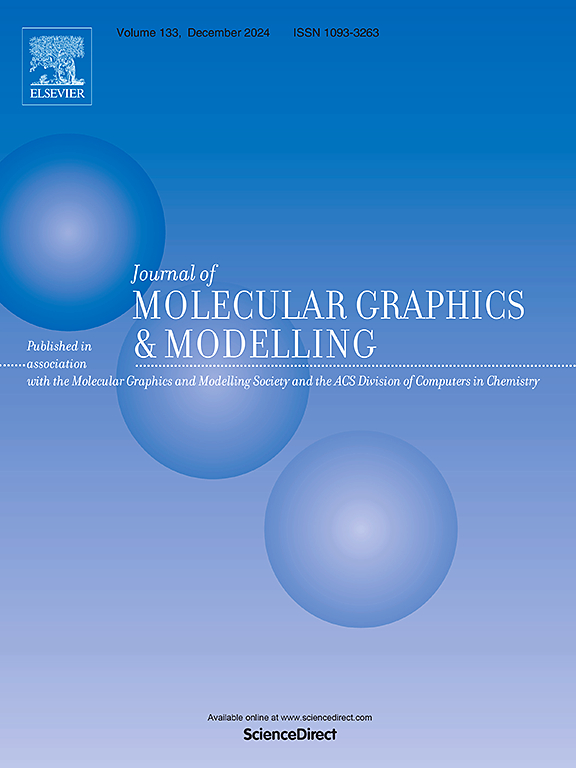通过结构启发虚拟筛选研究发现新的微粒体前列腺素E2合成酶1 (mPGES-1)抑制剂。
IF 2.7
4区 生物学
Q2 BIOCHEMICAL RESEARCH METHODS
引用次数: 0
摘要
前列腺素(PG) E2是一种促炎脂质介质,来源于花生四烯酸(AA)的环氧化酶(COX)和PGE2合成酶的代谢。非甾体抗炎药(NSAIDs),通常用于治疗炎症,非选择性地抑制COX活性和降低PGE2的产生。然而,这些药物会引起胃肠道出血和一些心血管并发症。因此,抑制微粒体PGE2合成酶-1 (mPGES-1)以阻断COX下游PGE2的产生有望为炎症、癌症和心血管疾病提供更安全、更有效的治疗方法。目前,市场上还没有mPGES-1抑制剂,但正在进行的研究不断地在临床前和临床阶段评估新化合物。在这里,我们进行了一个高通量的虚拟筛选活动,以发现新的mPGES-1抑制剂支架。该活动利用了物理化学过滤以及基于结构感知的配体方法(形状筛选模板和药效团模型,这些方法是基于共结晶mPGES-1抑制剂的3D结合模式生成的)和基于结构的策略(通过对接和分子动力学进行改进)。选择34种化合物,并在无细胞实验中对mPGES-1进行生物学测试,使用来自白细胞介素-1β刺激的A549细胞的微粒体作为mPGES-1的来源。在PGE2生产的无细胞实验中,最有效的化合物抑制剩余酶活性的IC50值为6.46 μM。我们还使用分子动力学模拟比较了本研究中鉴定的最活性化合物与共结晶抑制剂的结合模式。这种比较强调了离子相互作用、π-π相互作用、氢键和涉及特定氨基酸的水桥的关键作用。我们的研究结果强调了这些相互作用网络在结合腔中的重要性。最终,从这项研究中获得的见解可以帮助设计和开发新的mPGES-1抑制剂。本文章由计算机程序翻译,如有差异,请以英文原文为准。

Discovery of novel microsomal prostaglandin E2 synthase 1 (mPGES-1) inhibitors by a structurally inspired virtual screening study
Prostaglandin (PG) E2 is a pro-inflammatory lipid mediator derived from the metabolism of arachidonic acid (AA) by cyclooxygenases (COX) and PGE2 synthases. Nonsteroidal anti-inflammatory drugs (NSAIDs), commonly used in the treatment of inflammation, nonselectively inhibit COX activity and decrease PGE2 production. However, these drugs cause gastrointestinal bleeding and several cardiovascular complications. Therefore, inhibiting microsomal PGE2 Synthase-1 (mPGES-1) to block PGE2 production downstream of COX is expected to yield safer and more effective treatments for inflammation, cancer, and cardiovascular diseases. At present, there are no mPGES-1 inhibitors available on the market, but ongoing research continuously evaluates new compounds in both preclinical and clinical stages. Here, we conducted a high throughput virtual screening campaign to discover novel mPGES-1 inhibitor scaffolds. This campaign utilized physicochemical filtering alongside both structure-aware ligand-based approaches (shape screening templates and pharmacophore models, which were generated based on the 3D binding modes of the co-crystallized mPGES-1 inhibitors) and structure-based strategies (refinement with docking and molecular dynamics). Thirty-four compounds were selected and biologically tested for mPGES-1 inhibition in a cell-free assay using microsomes from interleukin-1β-stimulated A549 cells as the source of mPGES-1. The most potent compound inhibited the remaining enzyme activity with an IC50 value of 6.46 μM in a cell-free assay for PGE2 production. We also compared the binding patterns of the most active compounds identified in this study with those of co-crystallized inhibitors using molecular dynamics simulations. This comparison underscored the crucial role of ionic interactions, π-π interactions, hydrogen bonds, and water bridges involving specific amino acids. Our results highlight the importance of these interaction networks within the binding cavity in various binding scenarios. Ultimately, the insights gained from this study could assist in designing and developing new mPGES-1 inhibitors.
求助全文
通过发布文献求助,成功后即可免费获取论文全文。
去求助
来源期刊

Journal of molecular graphics & modelling
生物-计算机:跨学科应用
CiteScore
5.50
自引率
6.90%
发文量
216
审稿时长
35 days
期刊介绍:
The Journal of Molecular Graphics and Modelling is devoted to the publication of papers on the uses of computers in theoretical investigations of molecular structure, function, interaction, and design. The scope of the journal includes all aspects of molecular modeling and computational chemistry, including, for instance, the study of molecular shape and properties, molecular simulations, protein and polymer engineering, drug design, materials design, structure-activity and structure-property relationships, database mining, and compound library design.
As a primary research journal, JMGM seeks to bring new knowledge to the attention of our readers. As such, submissions to the journal need to not only report results, but must draw conclusions and explore implications of the work presented. Authors are strongly encouraged to bear this in mind when preparing manuscripts. Routine applications of standard modelling approaches, providing only very limited new scientific insight, will not meet our criteria for publication. Reproducibility of reported calculations is an important issue. Wherever possible, we urge authors to enhance their papers with Supplementary Data, for example, in QSAR studies machine-readable versions of molecular datasets or in the development of new force-field parameters versions of the topology and force field parameter files. Routine applications of existing methods that do not lead to genuinely new insight will not be considered.
 求助内容:
求助内容: 应助结果提醒方式:
应助结果提醒方式:


